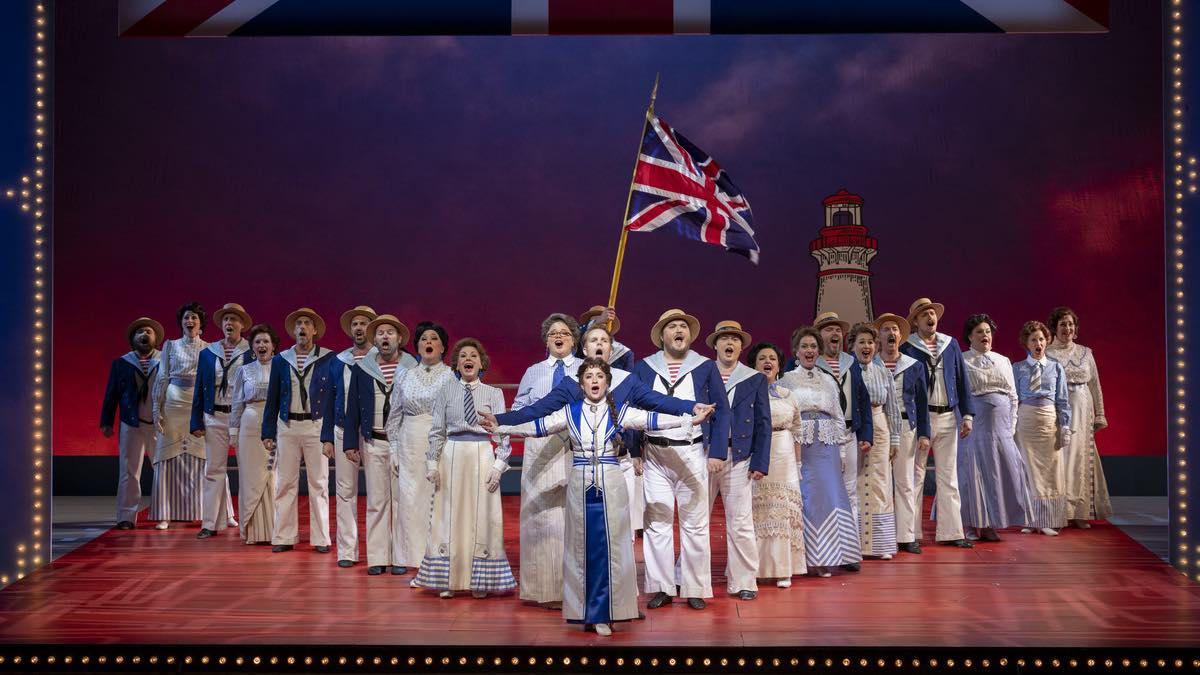5 rollicking stars
Presented by: State Opera South Australia
Reviewed: 12 May, 2023
This is a Pinafore to please all. From rusted-on traditionalists who swear (oops!) by D’Oyley Carte through to modern revisionists who use critical theory to analyse the semiotics of power in theatre, all can find entertainment, amusement and satisfying artistry in director Stuart Maunder’s seaworthy production. Season-ticket opera-lovers and audiences who have never before seen a Gilbert and Sullivan opera are alike set at ease and consistently charmed by this nautical gem.
The pre-show stage set consists of a fourteen-foot high (in old money) seagull, with a banner bearing the show’s title in its beak. The back wall of the stage is a gigantic Union Jack flag. We get the idea early. The storyline is minimal, the libretto is magical, and the music brings everything together. This is the theatrical miracle of Gilbert’s text and lyrics set to Sullivan’s music. The story of H.M.S. Pinafore examines relationships between people of higher and lower status. The hierarchical nature of the Navy allows Gilbert to have rich fun with differences in rank, whilst social presumptions, stigmas and foibles are comic gifts. Clever, witty and utterly memorable, Gilbert’s words retain their sharp edge of satire. He is a master comic librettist. His words nest neatly within Sullivan’s evocative music. The score ranges from orchestral lush to end-of-the-pier brass band… but always supports the theatrical mood. With James Pratt conducting the performance, the Adelaide Symphony Orchestra sounds superb. Pratt’s tempi are spot-on, and his management of dynamic levels always works to support the performers.
Playing Captain Corcoran, the captain of the ship, is Jeremy Kleeman, whose wit, energy and constant focus power his performance. He can act, he can move and he can sing. From his surprise first appearance, when he declares “I am the captain of the Pinafore”, his vocal worth is evident, with clear, precise articulation and warmly resonant tone. His Act 2 opener, “Fair moon, to thee I sing”, shows off his excellent legato line. Kleeman is a very fine artist.
Clad in swirling patchwork skirts, Antoinette Halloran plays Mrs Cripps (a.k.a. “Little Buttercup”). Halloran’s signature zest drives this character, with her showcase performance of “A many years ago” a tribute to her acting as well as her breadth of singing skills. Her powerful presence helps to anchor the whole show.
Although he bears an unsettling resemblance to Billy Connolly (with eyepatch), rumbling Douglas McNicol plays the nefarious Dick Deadeye – yet one more enjoyable character from this seasoned, versatile performer.
Juvenile lead roles are often the most thankless of tasks. As young, lowly sailor Ralph Rackstraw, Nicholas Jones brings glorious tenor tonal quality, affable personality and physical dynamism to the role. He makes the character a fully-rounded, believable one, instead of a juve-lead sketch. For this he deserves high praise. Jessica Dean plays his love interest, Josephine, with sweetness, coy grace and a luscious soprano tone. Although her spoken lines are sometimes faint, and her sung vocal quality tends to overwhelm her articulation, the glory of her singing voice is rewarding.
When we meet the men’s chorus, they are busy swabbing the decks of their ship (“We sail the ocean blue”). The muscular vocal quality of their choral work is immediately apparent. Throughout the show, their performance is exemplary, with excellent articulation, beautifully managed dynamic shifts and well-blended tone. They move well, work cooperatively and never fail to entertain. Another word about the men’s chorus. They are all in naval uniform of the period, which includes white bell-bottomed trousers. Costume designer Roger Kirk, faithful to the fashion of the day, has ensured that those trousers should fit snugly around the hip area. Both the director and choreographers (Elizabeth Hall-Cooper, and Anna Tsirigotis in rehearsals) exploit this fashion trend. At certain times, the stage becomes a veritable gluteal symphony. And I’m not complaining.
The women’s chorus, clad in late Victorian splendour by clever Roger Kirk, sing superbly, move with grace and good cheer, and sound wonderful together.
Ben Mingay, as Sir Joseph Porter, couldn’t put a foot wrong all night. His portrayal of a languid upper-crust clubbable chap, somewhat well-whiskied and entirely convinced of his superiority to almost everyone, is comic gold. His mannerisms are exquisitely gauged for maximum effect. Whilst singing beautifully, he also entertains richly with super-clear articulation, facial nuances aplenty and an actor’s sense of mischief. His performance is alone worth the price of the ticket.
Richard Roberts’ set design is remarkable. While many visual cues recall the traditions associated with late 19th century-era G&S, there are quiet, surreptitious nods to today’s audience too – like the bike wheels on Little Buttercup’s dinghy. His design sensibility is superb, placing a unique stamp on this production. Sound design by Jamie Mensforth maintains a vital balance in this sonic-based artform, while Trudy Dalgliesh’s lighting design explains, highlights and mystifies, always heightening the theatrical effect.
A final word to Adelaide’s own operatic Cameron Mackintosh, Stuart Maunder: Thank you for this 10-day celebratory feast of G&S. It’s just what the doctor ordered.
Reviewed by Pat H. Wilson
Photo credit: Frankie The Creative
Venue: Her Majesty’s Theatre
Season: 12th, 13th, 19th May at 7.30pm; 20th May at 2:00pm
Duration: 1 hour 50 minutes (including interval)
Tickets:
Premium: $140
A Reserve: $110, Conc $99, Child 3-17yo $30
B Reserve: $90, Conc $81, Family (2 adults + 2 children) $219, Child 3-17yo $30
C Reserve: $71, Conc $62, Family (2 adults + 2 children) $186, Child 3-17yo $30
Bookings: https://gandsfest.com/event/h-m-s-pinafore/





















